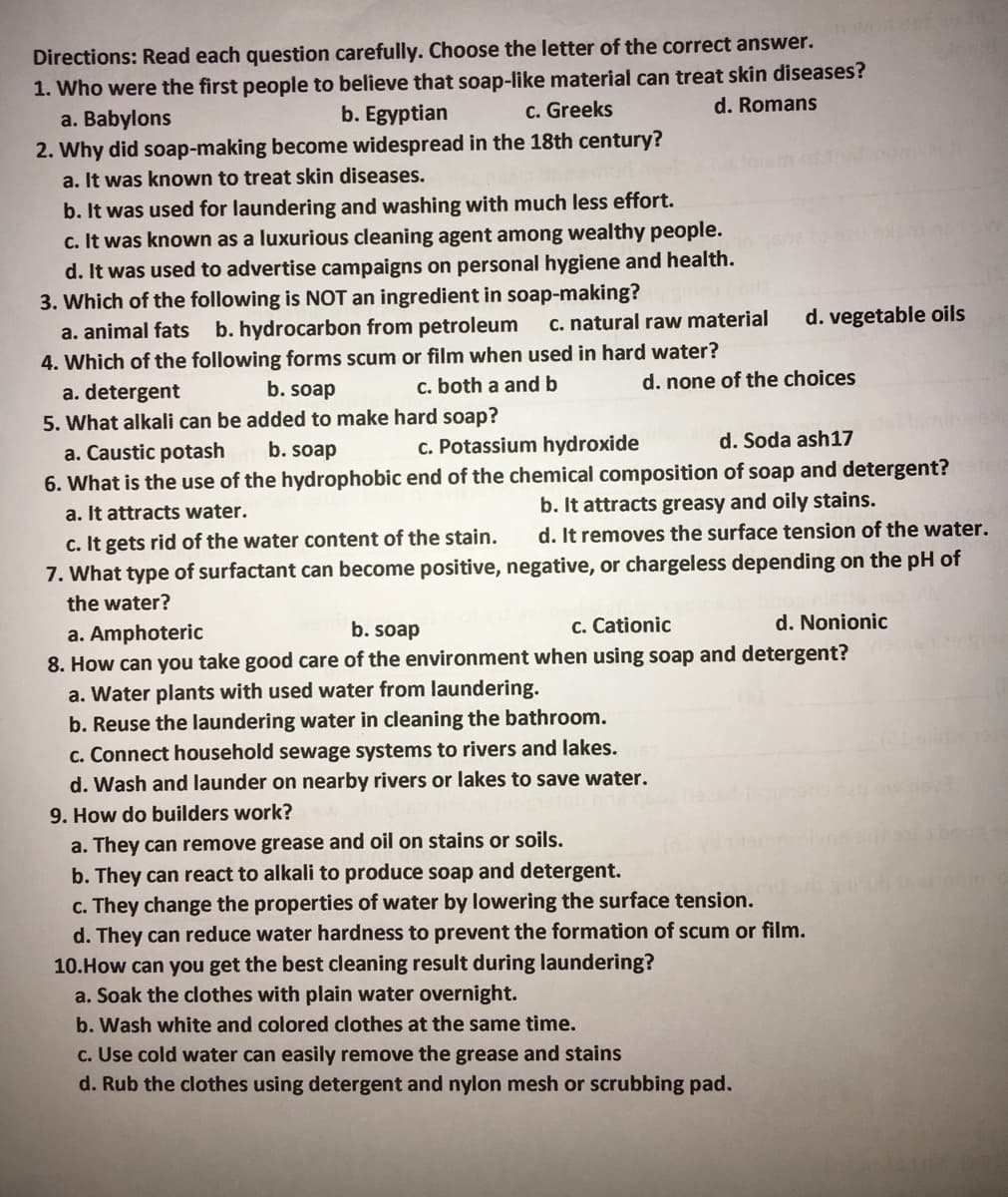t was known to treat skin diseases. It was used for laundering and washing with much less effort. t was known as a luxurious cleaning agent among wealthy people. It was used to advertise campaigns on personal hygiene and health. nich of the following is NOT an ingredient in soap-making? animal fats nich of the following forms scum or film when used in hard water? detergent nat alkali can be added to make hard soap? Caustic potash b. hydrocarbon from petroleum C. natural raw material b. soap c. both a and b d. none of the b. soap c. Potassium hydroxide d. Soda nd of the chemical composition of soar
t was known to treat skin diseases. It was used for laundering and washing with much less effort. t was known as a luxurious cleaning agent among wealthy people. It was used to advertise campaigns on personal hygiene and health. nich of the following is NOT an ingredient in soap-making? animal fats nich of the following forms scum or film when used in hard water? detergent nat alkali can be added to make hard soap? Caustic potash b. hydrocarbon from petroleum C. natural raw material b. soap c. both a and b d. none of the b. soap c. Potassium hydroxide d. Soda nd of the chemical composition of soar
Chapter17: Drugs And Medicine: Healing, Helping, And Hurting
Section: Chapter Questions
Problem 72E
Related questions
Question

Transcribed Image Text:Directions: Read each question carefully. Choose the letter of the correct answer.
1. Who were the first people to believe that soap-like material can treat skin diseases?
a. Babylons
2. Why did soap-making become widespread in the 18th century?
a. It was known to treat skin diseases.
b. It was used for laundering and washing with much less effort.
c. It was known as a luxurious cleaning agent among wealthy people.
d. It was used to advertise campaigns on personal hygiene and health.
3. Which of the following is NOT an ingredient in soap-making?
b. Egyptian
c. Greeks
d. Romans
c. natural raw material
d. vegetable oils
a. animal fats
b. hydrocarbon from petroleum
4. Which of the following forms scum or film when used in hard water?
a. detergent
5. What alkali can be added to make hard soap?
a. Caustic potash
6. What is the use of the hydrophobic end of the chemical composition of soap and detergent?
b. soap
c. both a and b
d. none of the choices
b. soap
c. Potassium hydroxide
d. Soda ash17
b. It attracts greasy and oily stains.
d. It removes the surface tension of the water.
a. It attracts water.
c. It gets rid of the water content of the stain.
7. What type of surfactant can become positive, negative, or chargeless depending on the pH of
the water?
b. soap
c. Cationic
d. Nonionic
a. Amphoteric
8. How can you take good care of the environment when using soap and detergent?
a. Water plants with used water from laundering.
b. Reuse the laundering water in cleaning the bathroom.
c. Connect household sewage systems to rivers and lakes.
d. Wash and launder on nearby rivers or lakes to save water.
9. How do builders work?
a. They can remove grease and oil on stains or soils.
b. They can react to alkali to produce soap and detergent.
c. They change the properties of water by lowering the surface tension.
d. They can reduce water hardness to prevent the formation of scum or film.
10.How can you get the best cleaning result during laundering?
a. Soak the clothes with plain water overnight.
b. Wash white and colored clothes at the same time.
c. Use cold water can easily remove the grease and stains
d. Rub the clothes using detergent and nylon mesh or scrubbing pad.
Expert Solution
This question has been solved!
Explore an expertly crafted, step-by-step solution for a thorough understanding of key concepts.
Step by step
Solved in 3 steps with 3 images

Knowledge Booster
Learn more about
Need a deep-dive on the concept behind this application? Look no further. Learn more about this topic, chemistry and related others by exploring similar questions and additional content below.Recommended textbooks for you


Chemistry for Engineering Students
Chemistry
ISBN:
9781285199023
Author:
Lawrence S. Brown, Tom Holme
Publisher:
Cengage Learning

Chemistry In Focus
Chemistry
ISBN:
9781305084476
Author:
Tro, Nivaldo J., Neu, Don.
Publisher:
Cengage Learning


Chemistry for Engineering Students
Chemistry
ISBN:
9781285199023
Author:
Lawrence S. Brown, Tom Holme
Publisher:
Cengage Learning

Chemistry In Focus
Chemistry
ISBN:
9781305084476
Author:
Tro, Nivaldo J., Neu, Don.
Publisher:
Cengage Learning